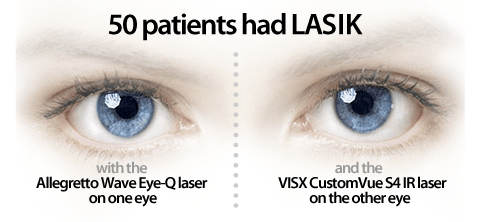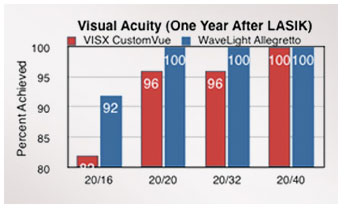
Stanford Medicine’s LASIK study compares two lasers head-to-head
 Stanford Medicine’s “Laser Comparison Study”: 50 patients (100 eyes) had Wavefront LASIK with the WaveLight Allegretto laser on one eye and the VISX CustomVue S4 IR laser on the other eye. In this scientifically-controlled study, the “5th generation iFS 150 Intralase femtosecond laser” (All-Laser LASIK) was also used for all eyes of both groups.
Stanford Medicine’s “Laser Comparison Study”: 50 patients (100 eyes) had Wavefront LASIK with the WaveLight Allegretto laser on one eye and the VISX CustomVue S4 IR laser on the other eye. In this scientifically-controlled study, the “5th generation iFS 150 Intralase femtosecond laser” (All-Laser LASIK) was also used for all eyes of both groups.
Results:
One year after LASIK, both wavefront lasers safely and effectively treated nearsightedness. However, several statistically-significant differences were identified:
REFERENCE/SCIENTIFIC ABSTRACT
1 Comparison of 2 wavefront-guided excimer lasers for myopic laser in situ keratomileusis: one-year results. Yu CQ, Manche E. J Cataract Refract Surg. 2014 Mar;40(3):412-22.
Purpose
To compare laser in situ keratomileusis (LASIK) outcomes between two wavefront-guided excimer laser systems in the treatment of myopia.
Setting
University eye clinic, Palo Alto, California, USA.
Design
Prospective comparative case series.
Methods
One eye of patients was treated with the Allegretto Wave Eye-Q system (small-spot scanning laser) and the fellow eye with the VISX Star Customvue S4 IR system (variable-spot scanning laser). Evaluations included measurement of uncorrected visual acuity, corrected visual acuity, and wavefront aberrometry.
Results
One hundred eyes (50 patients) were treated. The mean preoperative spherical equivalent (SE) refraction was −3.89 diopters (D) ± 1.67 (SD) and −4.18 ± 1.73 D in the small-spot scanning laser group and variable-spot scanning laser group, respectively. There were no significant differences in preoperative higher-order aberrations (HOAs) between the groups. Twelve months postoperatively, all eyes in the small-spot scanning laser group and 92% in the variable-spot scanning laser group were within ±0.50 D of the intended correction (P = .04). At that time, the small-spot scanning laser group had significantly less spherical aberration (0.12 versus 0.15) (P = .04) and significantly less mean total higher-order root mean square (0.33μm versus 0.40 μm) (P = .01). Subjectively, patients reported that the clarity of night and day vision was significantly better in the eye treated with the small-spot scanning laser.
Conclusions
The predictability and self-reported clarity of vision of wavefront-guided LASIK were better with the small-spot scanning laser (WaveLight Allegretto). Eyes treated with the small-spot scanning laser (WaveLight Allegretto) had significantly fewer HOAs.
606 Saratoga Ave,
San Jose, CA 95129
5790 Stoneridge Mall Rd, Pleasanton, CA 94588